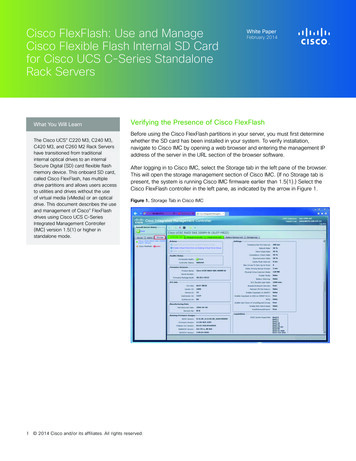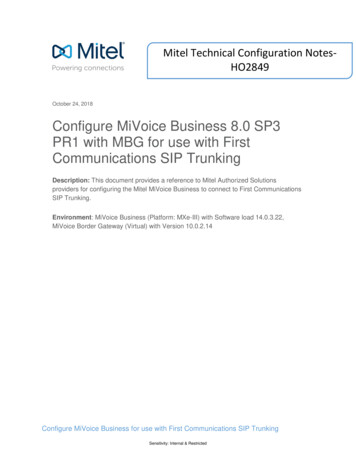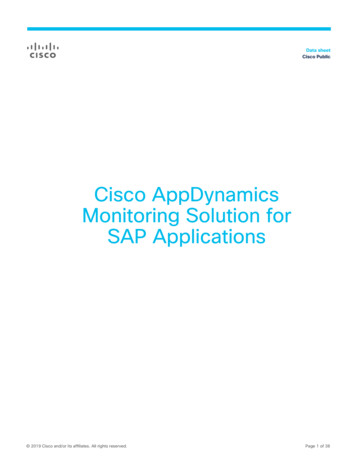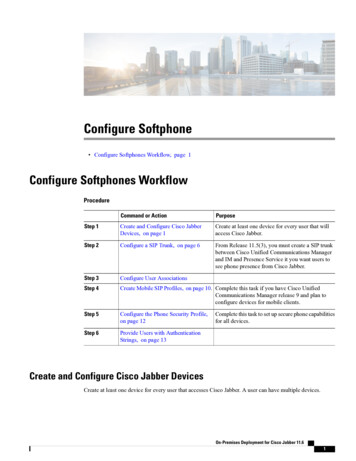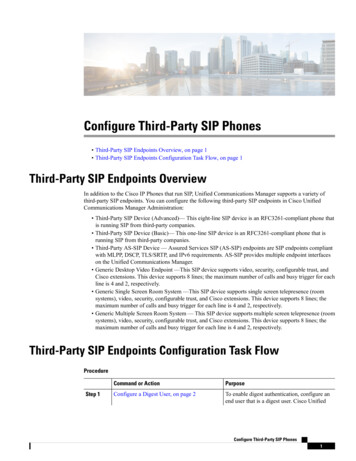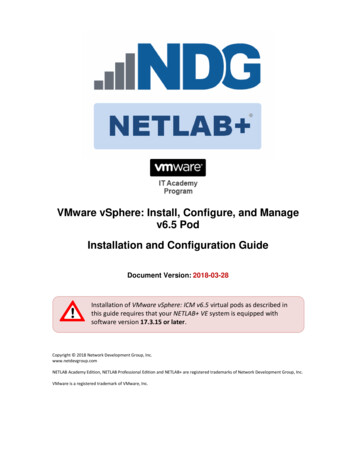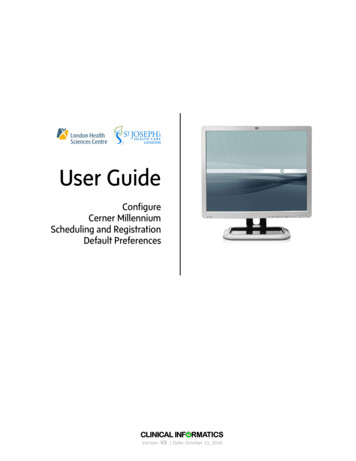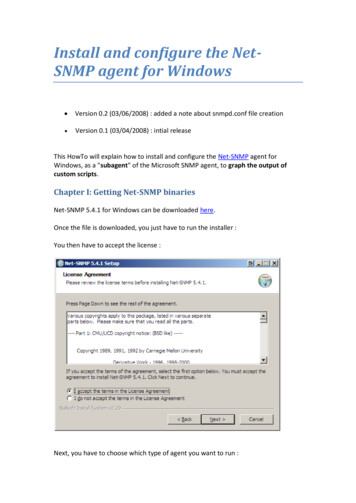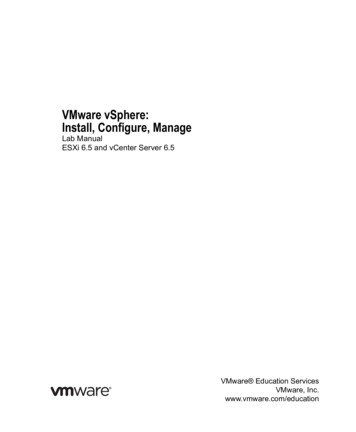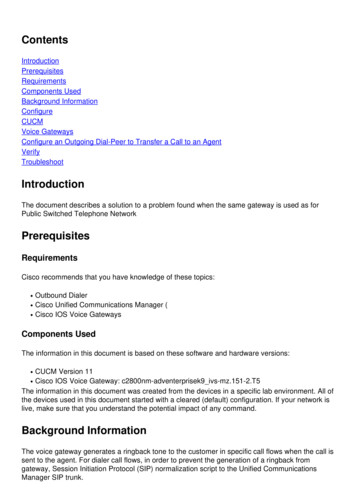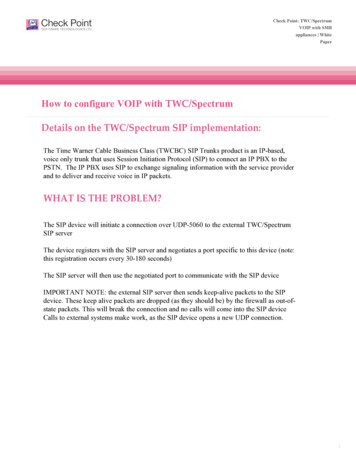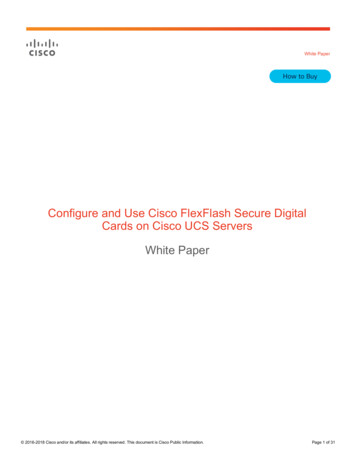
Transcription
White PaperHow to BuyConfigure and Use Cisco FlexFlash Secure DigitalCards on Cisco UCS ServersWhite Paper 2016-2018 Cisco and/or its affiliates. All rights reserved. This document is Cisco Public Information.Page 1 of 31
ContentsIntroduction . 3Definitions . 3SD Installation . 3SD Card and SD Controller Cisco UCS Server Support Matrix. 3Cisco UCS B-Series and C-Series Servers Operating in Cisco UCS Manager Mode . 4Verifying an SD Card in Server Inventory in Cisco UCS Manager . 4Configuring and Mirroring SD Cards in Cisco UCS Manager . 5Creating a Scrub Policy . 7Booting from a Cisco FlexFlash SD Card. 9Using Out-of-Band Management . 10Enabling Auto Sync . 10Formatting Cisco FlexFlash SD Cards . 11Resetting the Cisco FlexFlash Controller . 11Cisco UCS C-Series Servers Operating in Standalone Mode . 12Using Cisco FlexFlash SD Card Partitions . 12Moving to a One-Partition Layout from a Four-Partition Layout . 13Using Virtual Drive Partitions . 17Using Mirror Mode with Cisco IMC 1.4 and 1.5 . 18Cisco FlexFlash Controller FX3S . 20Using Mirror Mode and Auto Sync . 21Using Utility Mode . 22Updating a Utility Partition . 23Enabling Virtual Drive Presentation to the Server Host . 25Using Cisco FlexFlash with Cisco IMC 1.4. 26Upgrading from Cisco IMC 1.4 to 1.5: Troubleshooting . 27Q&A . 29 2016-2018 Cisco and/or its affiliates. All rights reserved. This document is Cisco Public Information.Page 2 of 31
IntroductionThis document provides instructions on configuring and using Cisco FlexFlash Secure Digital (SD) cards on CiscoUCS B-Series Blade Servers and C-Series Rack Servers. This document is divided into two major sectionsdiscussing the two operating modes for the servers: Cisco UCS Manager mode can be used for Cisco UCS B-Series Blade Servers and C-Series Rack Serversthat are integrated into the Cisco Unified Computing System (Cisco UCS). Standalone mode can be used for standalone Cisco UCS C-Series Rack Servers.DefinitionsNote the following definitions are specific to this document: Mirror pair: Data on two identically sized SD cards is copied exactly across the cards. Note that automaticrebuilding will not occur. The user must manually initiate rebuilding if one of the SD cards fails. Auto synchronization (Auto Sync): Data on two identically sized SD cards is copied exactly across thecards. Automatic rebuilding will occur upon replacement of an existing card with a new blank SD card. RAID and RAID1: In some images in this document, Cisco UCS Manager and Cisco IntegratedManagement Controller (IMC) interfaces refer to “RAID.” However, with SD cards, RAID actually refers tothe mirror definition. SD card will not be automatically rebuilt unless Auto Sync is enabled.SD InstallationFor information about the physical installation of SD cards in Cisco UCS servers, please refer to the installationdocumentation or technical specifications on Cisco.com for Cisco UCS B-Series and C-Series servers. The SD slotlocations are different depending on the server.SD Card and SD Controller Cisco UCS Server Support MatrixTables 1 and 2 list the Cisco UCS B-Series and C-Series server models that support the Cisco FlexFlash SDcards. Note that there are two versions of FlexFlash SD controllers and a variety of SD card capacities.Table 1.Cisco UCS B-Series Blade Servers: SD Card and Controller Support MatrixBlade ServerNo SupportCisco FlexFlash SD ControllerCisco FlexFlash SD Controller FX3S16 GB32 GB64 GBCisco UCS B200 M4YesYesCisco UCS B420 M4YesYes32 GBCisco UCS B260 M4YesCisco UCS B460 M4YesCisco UCS B200 M3YesYesCisco UCS B420 M3YesYesYesYesCisco UCS B22 M3Cisco UCS B230 M2YesCisco UCS B440 M2Yes 2016-2018 Cisco and/or its affiliates. All rights reserved. This document is Cisco Public Information.Page 3 of 31
Table 2.Cisco UCS C-Series Rack Servers: SD Card and Controller Support MatrixRack ServerNo SupportCisco FlexFlash SD ControllerCisco FlexFlash SD Controller FX3S16 GB32 GB64 GBCisco UCS C220 M4YesYesCisco UCS C240 M4YesYes32 GBYesCisco UCS C460 M4Cisco UCS C220 M3YesYesCisco UCS C240 M3YesYesCisco UCS C420 M3YesYesYesYesCisco UCS C22 M3YesCisco UCS C24 M3YesCisco UCS C460 M2YesCisco UCS C260 M2Cisco UCS B-Series and C-Series Servers Operating in Cisco UCS Manager ModeThis section describes how to use the FlexFlash Controller FX3S for Cisco UCS Manager Mode with the IMCRelease 2.2(1a) or later.Verifying an SD Card in Server Inventory in Cisco UCS ManagerTo verify the presence of an SD card, log in to Cisco UCS Manager and navigate to the server’s inventory. UnderInventory, select the Storage tab, as shown in Figure 1.Figure 1.Storage Tab in Server InventoryThe communication between the host server and the SD controller is USB based. Thus, the enumerated partitionof the SD card is presented as a USB drive to the server. When an SD card is discovered in a server, ControllerState should be displayed as Connected Partition Over USB To Host, which means that the controller is connectedto the SD card partition, the BIOS, and the host server. If there are errors in the controller state, click ResetFlexFlash Controller. After the FlexFlash controller is reset, Controller State should display as Connected PartitionOver USB To Host as shown in Figure 1.To verify the details of the SD card, click the down arrow to the right of FlexFlash Cards, as shown in Figure 2.Details should be displayed as shown in Figure 3. 2016-2018 Cisco and/or its affiliates. All rights reserved. This document is Cisco Public Information.Page 4 of 31
Figure 2.Cisco FlexFlash SD CardsFigure 3.Cisco FlexFlash DetailsNote:Cisco does not support the installation of an SD card taken from a Cisco UCS C-Series server into aCisco UCS B-Series server, or the reverse. Swapping SD cards from a rack server to a blade server, or thereverse, may result in data loss on the SD card. You may be able to reformat the SD card, but reformatting alsoresults in data loss.Configuring and Mirroring SD Cards in Cisco UCS ManagerFlexFlash SD cards are disabled by default. To configure and enable them, in Cisco UCS Manager, create a policyunder Local Disk Configuration Policy within a service profile (see Figure 4).Note:SD cards must be the same size for them to be mirrored. When FlexFlash is enabled through a local diskpolicy, the FlexFlash controller becomes enabled during service profile deployment. If a server does not supportSD cards or is using a release earlier than IMC Release 2.2(1a), a configuration failure message is displayed. 2016-2018 Cisco and/or its affiliates. All rights reserved. This document is Cisco Public Information.Page 5 of 31
Figure 4.Local Disk Configuration Policy to Enable Cisco FlexFlash CardIf FlexFlash is disabled in a supported server by setting FlexFlash State to Disable in the local disk configurationpolicy or by disassociating the service profile, the hypervisor (HV) partition will immediately be disconnected fromthe server host. The FlexFlash controller will also be disabled as part of a related service profile disassociation.After the service profile is associated with a server containing dual (two) SD cards, it automatically starts mirroringand displays Enabled Paired, as shown in Figure 5.Figure 5.Verifying Mirroring (or Paired) Status After Service Profile Association 2016-2018 Cisco and/or its affiliates. All rights reserved. This document is Cisco Public Information.Page 6 of 31
Creating a Scrub PolicyThe FlexFlash SD controller does not support mirror rebuilding.If you are using an SD card that uses the more advanced FX3S controller (see Tables 1 and 2 earlier in thisdocument), consider enabling Auto Sync as described in the section Using Out-of-Band Management later in thisdocument.If the SD cards are in a degraded RAID State, or if any metadata errors are reported by the controller (for example,RAID State: Enable Paired; Invalid Secondary), you need a FlexFlash scrub policy to pair the cards for mirroring orto resolve metadata errors while mirroring.A degraded RAID state or metadata errors may occur if you: Add a new SD card Insert a SD card from a different serverIn Cisco UCS Manager, Scrub Policy is under Service Profiles Policies, as shown in Figure 6. To configure SDcards in a RAID pair, create a FlexFlash scrub policy and reacknowledge the server. The FlexFlash scrub policyerases the hypervisor partition (if present) in both cards, and reformats the cards to a healthy RAID state. As soonas the mirroring is complete, as a best practice you should disable the scrub policy immediately by setting ScrubPolicy to default, as shown in Figure 7.Figure 6.Scrub Policy 2016-2018 Cisco and/or its affiliates. All rights reserved. This document is Cisco Public Information.Page 7 of 31
Figure 7.Disabling Scrub Policy by Setting It to defaultIf the scrub policy is still enabled after the pairing, and if any subsequent discovery or reassociation event occurs,then the cards will be reformatted. Thus, it is important to disable the scrub policy after this step is completed. 2016-2018 Cisco and/or its affiliates. All rights reserved. This document is Cisco Public Information.Page 8 of 31
Figure 8 shows the created scrub policy.Figure 8.Creating Scrub PolicyBooting from a Cisco FlexFlash SD CardTo boot from an SD card, the SD card must be present in the boot policy used in the service profile, as shown inFigure 9.Note:Prior to IMC Release 2.2, booting had to be performed through the BIOS, not through the service profile. 2016-2018 Cisco and/or its affiliates. All rights reserved. This document is Cisco Public Information.Page 9 of 31
Figure 9.Creating a Boot Policy for a Cisco FlexFlash SD CardUsing Out-of-Band ManagementEnabling Auto SyncFor SD cards with the more advanced FlexFlash Controller FX3S (see Tables 1 and 2), if the cards become out ofsync, the Auto-sync feature can resynchronize the cards automatically without user interaction. To use this feature,click Enable Auto-sync. At the Admin Slot Number prompt, enter a slot number so that Cisco UCS Manager knowswhich card has the data to be mirrored to the other card (see Figure 10). The slot you select becomes the primarycard for mirroring. 2016-2018 Cisco and/or its affiliates. All rights reserved. This document is Cisco Public Information.Page 10 of 31
Figure 10.Enabling Auto SyncAfter you make a selection, the controller begins mirroring the primary SD card in the identified slot number to thesecondary SD card. While Auto Sync is enabled, if one of the SD cards is replaced with another card, the controllerwill mirror the primary SD card data to the new card in the slot. It does not matter if the primary or secondary SDcard is replaced; the controller will automatically mirror the SD card located in the server to a new SD card.Formatting Cisco FlexFlash SD CardsYou can format SD cards to destroy existing data, as well as to help ensure that the latest (and matching) controllermetadata is written to the SD cards. Formatting is recommended after you install a blank spare card or a card thatwas moved from another server host. The data on both cards is destroyed in the process, so this action should beused with caution. Figure 11 shows the procedure.Figure 11.Formatting SD CardsResetting the Cisco FlexFlash ControllerYou can reset the FlexFlash controller in Cisco UCS Manager. Doing so can be helpful for troubleshootingunexpected behaviors. Resetting the FlexFlash controller results in loss of connectivity between the server hostand its SD cards. Figure 12 shows the procedure. 2016-2018 Cisco and/or its affiliates. All rights reserved. This document is Cisco Public Information.Page 11 of 31
Figure 12.Resetting the Cisco FlexFlash ControllerCisco UCS C-Series Servers Operating in Standalone ModeSD card operations and details are on the Storage tab of the IMC interface. This tab contains details about thecontroller, physical drives, and virtual drives, as shown in Figure 13.Figure 13.Cisco IMC Storage Tab ViewUsing Cisco FlexFlash SD Card PartitionsIn IMC Releases 1.4 and 1.5, four partitions were preconfigured in the Cisco factory on the SD cards, as shown onthe left side in Figure 14. The partition sizes are static, no matter what size of SD card is installed. 2016-2018 Cisco and/or its affiliates. All rights reserved. This document is Cisco Public Information.Page 12 of 31
Figure 14.Cisco FlexFlash Partitions for Cisco UCS C-Series Standalone Rack Server ModeWith the release of IMC 1.5(4), three partitions were removed, leaving a single hypervisor partition. This changeenabled greater available user capacity on the SD card (see the right side of Figure 14). The 16-GB card has ausable partition of about 14.2 GB, and the 32-GB card has about 30 GB of usable space.Note these important considerations when implementing this single partition available in IMC 1.5(4): After you select the one-partition layout, you cannot revert to a four-partition layout without moving back toan earlier IMC release. Users currently using the hypervisor partition in the four-partition layout must reinstall the image on thehypervisor partition. If this reinstallation is not completed and the card has the Server Configuration Utility(SCU) image present, the SCU image will be available to the system for booting because it is the firstavailable partition segment on the card with the four-partition layout. Users currently using IMC 1.4 who wants to retain the four-partition layout should first update to IMC 1.5(1),perform Reset FlexFlash Controller, and then update to 1.5(4) before updating to a later release. Thisinterim update helps ensure that the firmware is at a level that supports both the existing four-partitionlayout as well as the one-partition layout. Upgrading from IMC 1.4 directly to a release later than IMC 1.5(4)automatically forces the SD card to the single-partition layout and is not recommended.Moving to a One-Partition Layout from a Four-Partition LayoutTo move to a single-partition layout from a four-partition layout, select Reset Partition Defaults. This results in thefollowing: The card in the selected slot is marked as “healthy primary.” The card in the other slot is marked as “unhealthy secondary-active.” One mirror partition is created. The card read-write error count and the read-write threshold are both set to zero. (Please see the Q&Asection at the end of this document to learn how to set a different read-write error threshold.) 2016-2018 Cisco and/or its affiliates. All rights reserved. This document is Cisco Public Information.Page 13 of 31
When Reset Partition Defaults is selected, a confirmation window appears, as shown in Figure 15.Figure 15.Confirmation Prompt for Moving from a Four-Partition to a One-Partition LayoutAfter you click Yes, a configuration option is displayed for the slot. This option should be set as “healthy primary,”as shown in Figure 16. The card not selected will be marked as “unhealthy secondary-active.” 2016-2018 Cisco and/or its affiliates. All rights reserved. This document is Cisco Public Information.Page 14 of 31
Figure 16.Reset Partition DefaultsAs a result of these changes to the partition defaults, the cards are no longer mirrored (if they were previously). Ifyou want to mirror the cards after you change the partition defaults, you must initiate the mirroring process usingthe SCU as described later in this document.After you configure the SD cards in the IMC, but before you mirror the hypervisor partition, the Controller Info tab inthe IMC GUI turns yellow to represent a degraded state, as shown in Figure 17. Even in this state, the primaryFlexFlash card is operational and available for customers to use.Note:Cisco UCS C-Series Rack Servers support FlexFlash SD card mirroring starting with IMC Release 1.5.Prior to IMC 1.5, the Degraded RAID status is displayed regardless of whether one or two cards are installed,because prior to IMC 1.5, SD card mirroring was not supported. 2016-2018 Cisco and/or its affiliates. All rights reserved. This document is Cisco Public Information.Page 15 of 31
Figure 17.Controller Info Tab Displaying “Degraded RAID” Status Before Mirroring Is ConfiguredMake sure that the primary card with the primary RAID role is listed as healthy, as shown on the Physical Drive Infotab in Figure 18. The second card is marked unhealthy with the secondary active RAID role. Cards withmismatched metadata cannot be paired until both cards are brought to the same code level. To bring each card tothe same code level, refer to the section Upgrading from Cisco IMC 1.4 to 1.5: Troubleshooting later in thisdocument. 2016-2018 Cisco and/or its affiliates. All rights reserved. This document is Cisco Public Information.Page 16 of 31
Figure 18.SD Card Health Status on Physical Drive Info Tab in Cisco IMCUsing Virtual Drive PartitionsPartitions presented by a healthy SD card are displayed on the Virtual Drive Info tab, shown in Figure 19. Thepartition sizes are static, because partitioning is implemented on the controller. Updates to the utility partitions inM3 servers ca
Figure 3. Cisco FlexFlash Details Note: Cisco does not support the installation of an SD card taken from a Cisco UCS C-Series server into a Cisco UCS B-Series server, or the reverse. Swapping SD cards from a rack server to a blade server, or the
